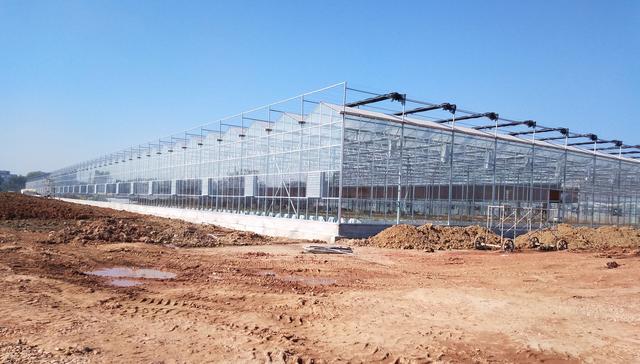
Attentions when you start to build a commercial greenhouse
Greenhouse growing is an intensive form of plant production and has the potential for high returns, but crops grown in greenhouses have exacting requirements and the markets have very high quality demand. So prospective new greenhouse growers must do their homework by critically evaluating their own experience, their abilities as managers and their financial backing.
If you want to start a new commercial greenhouse ,I would like to list “1H2W” that you should consider:
How Big a Greenhouse Is Needed?
Let’s assume you want to make $24,000 a year growing bedding plants (two-thirds of the money) and poinsettias (one-third of the money).Just guessing, you figure you can make $2.00 per flat profit on bedding plants and $1.00 per pot on poinsettias. That means you would need to grow 8,000 flats of bedding plants and 8,000 pots of poinsettias to earn your $24,000. Now that you have some very rough numbers, you can begin to assess the ability to actually sell that much product.Now, given that you have estimated a need to produce 8,000 flats of bedding plants in the spring, you can work backwards and estimate the greenhouse space needed. Most bedding plant growers have an early and a late crop, thus producing two “turns” of their space each spring. That means that 4,000 flats would be grown in the first turn and 4,000 in the second turn. If a bedding plant flat occupies 1.5 square feet per flat, then 6,000 square feet of growing space would be needed for each crop. Assuming that 70 percent of the greenhouse space is in “production space” and the remainder is in walks and isles, then a greenhouse with 8,570 sq. ft. would be needed (6,000 ÷ 0.7= 8,570). Our proposed poinsettia crop is grown on 14-inch centers; therefore, each plant will require 1.36 sq. ft. (142 ÷ 144 = 1.36 sq. ft.). Our 4,000 plants would require 5,440 square feet, so we have sufficient room to grow the crop in the space provided for the spring bedding crop. This example approximates what is needed space for a full-time greenhouse business. Most experts say that at least 6,000 sq. ft., but preferably 10,000 sq. ft., of greenhouse space is needed for a full-time operation.

What Is the Best Location for a Greenhouse?
Once the decision has been made between becoming a retail grower or a wholesale producer,several considerations must be taken into account before locating a greenhouse. Few sites will have every desirable feature, but the more closely the site can match the ideal, the more efficient the operation will be.
Location for retail growing.
Retail growers must have highly visible sites that have adequate room for parking and easy on and off road access. The ideal site would be visible from a highly traveled road yet not dangerous for customers to enter or exit. Some room for expansion of a retail site is always desirable.Most good retail locations will be provided with adequate utility services such as natural gas, city water and electricity. Sites that are too brightly lighted by street lights may cause problems in growing stray light sensitive crops such as poinsettias. Good retail sites will be expensive to acquire, but keep in mind that as long as the city is expanding in your direction, the land value will only increase over time.
Wholesale growing requirements:
A readily available, high-quality, year-round supply of water is one of the most important requirements for wholesale growing. Water quality, especially if taken from a well, must be checked for irrigation purposes before deciding to build a greenhouse range. Your local Cooperative Extension Service office can arrange for the test. The water requirements of a greenhouse range vary according to the kind of crop being grown but range from one-fourth gallon to one gallon per square foot per day during periods of peak demand.
What Will a Greenhouse Cost?
The fully automatic glass greenhouse system consists of: civil construction, main frame (steel frame), surrounding covering material, top covering material, external shading system, internal shading system (or internal insulation system), fan water curtain forced cooling ventilation system, top opening Window natural ventilation system, water curtain integral electric sash window system, power distribution system, engineering installation cost, transportation cost, tax.
For detailed cost to build a commercial greenhouse, no matter an agricultural greenhouse, a horticultural greenhouse or a nursery greenhouse, we can do our best to support you. As an experienced manufacturer of diffuse and anti-reflective glass for greenhouse, We have cooperated with Havecon,Van Der Hoeven and Pomas etc. large greenhouse project company for many years.
Reply your quotation as soon as possible!
Tags:anti-reflective glass diffuse glass agricultural greenhouses glass greenhouse venlo greenhouse AR glass greenhouses glass agricultural glass horticultural glass #greenhouseglass #Antireflectiveglass #Diffusetemperedglass #Ultrawhitefloatglass #agriculturalgreenhouseglass #diffuseglass #horticulturalglass #Tomatogreenhouse #Coloredpeppergreenhouse #Lettucegreenhouse #Agriculturalgreenhouse #ARglass #venlogreenhouse #greenhouseglass #Antireflectiveglass #Diffusetemperedglass #Ultrawhitefloatglass #agriculturalgreenhouseglass #diffuseglass #horticulturalglass #Tomatogreenhouse #Coloredpeppergreenhouse #Lettucegreenhouse #Agriculturalgreenhouse #ARglass #venlogreenhouse #GlassManufacturer #invernadero #ArchitecturalGlass #ClearFloatGlass #FloatGlass
Previous:Advantages of soilless cultivation in the agricultural hydroponics greenhouse
Next:Advantages of glass cover greenhouse over polycarbonate cover greenhouse



















